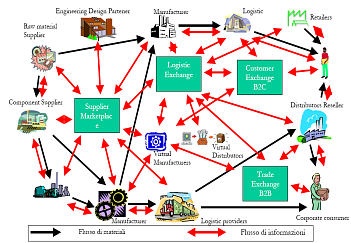From the study of the famous diagram that production, inventory and question of the customer closely are interconnected between they and they are influenced vicendevolmente.
The companies are found to operate in a market in which the speed and the service is indispensable requirement that push the enterprises to modify strategies and organization to the aim to reduce the Time-to-market and to operate in real time.
The concept of continuous logon is developed and of collaboration with the customers, the suppliers and the partner it trades them, it delineates therefore the model of “extensive enterprise”.
In the study of the productive systems an crescent has been taken place interest to the complex systems deriving from an extensive vision of the enterprise that more is not seen like independent entity, but like operating system in way interconnected with trading the partners.
The Supply Chain or Value Chain is the composed total net from economic entities which as an example: suppliers, manifacturing companies, warehouses, centers of distribution.
Often in order to define with of companies that operate in a shared atmosphere it makes reference the concept of virtual company that can be defined in the following way:
"A virtual company is with of independent operating units that act in integrated and organic way in order to shape every time best as chain of the value more adapted in order to pursue the opportunities of business that the market introduces."
A company represents an actor who operates in an atmosphere that is not get exaustedded in the four walls of the same one and therefore in order to catch up levels of excellence it must act in way integrated and organic with other entities of business.
The Supply Chain is a net of organizations that are been involved, through connections to mount and to they goes, in different processes and activity that they produce value in the shape of products and services assign you to the final consumer.
The actors of a merceologico field can be several and in elevated number, this renders the concept of Supply Chain much separating but several the definitions of the same one seem rather agree.
Some of continuation are brought back some:
Lee and Billington define it in the following way:
"A Supply Chain is a net of systems that power of attorney the raw materials, transforms to them in intermediate assets and end products and distributes such products to the customers through a distribution system."
While for Jayashankar:
"The Supply Chain is one of responsible independent seed or net independent entities business of the activities of supplying, production and distribution associated to one or more families than produced."
An other definition extends the previous ones characterizing a fundamental aspect which the sharing of the purposes:
"...it is a net of resources and points of distribution that carries out the functions of supplying of the materials, of transformation in intermediate and ended products, of distribution and delivery to the customers and is composed from independent enterprises that share common purposes".

Figure 4.1- Generic Supply Chain with flows of the products and the information